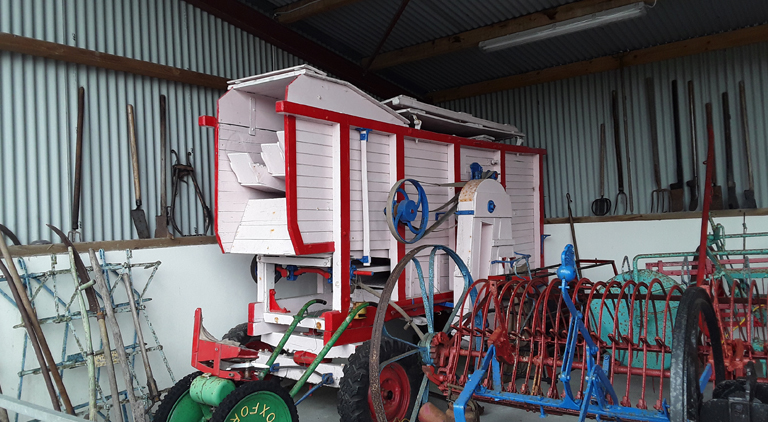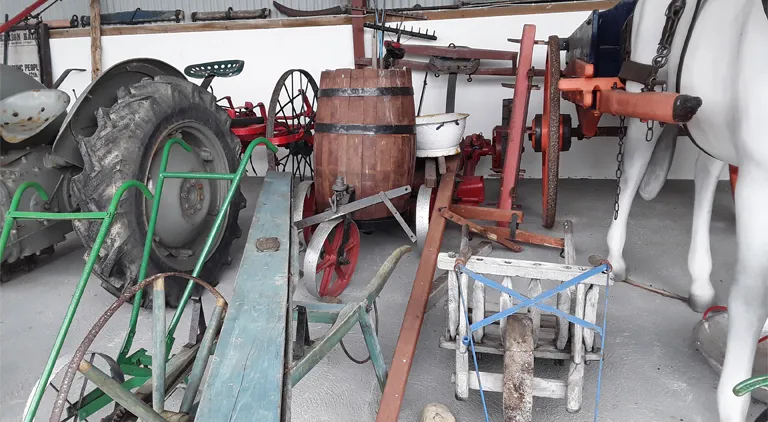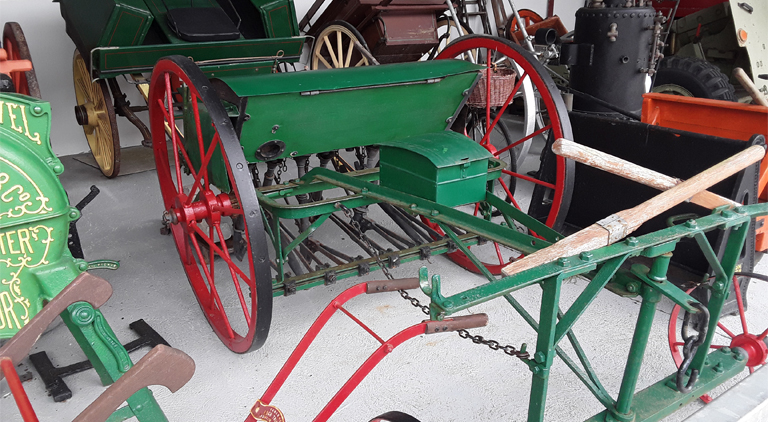
Micheál Geoghegan of Agridirect.ie talks to Brian Kennedy of the Glenview Museum about the museum’s extraordinary collection of farm machinery from the first half of the 20th century.
Before the tractor
On a mild May afternoon, I stood outside the Glenview Museum in Ballinamore, Co. Leitrim. The birds were singing in the museum’s leafy grounds. Before me, a shed full of tools and agricultural artefacts that seemed to me to have been borrowed from the set of The Quiet Man. There were carts and barrows, butter churns and hay turners, as well as seed sowing and grass cutting devices. There was a steaming machine for purifying mushroom houses, a couple of pig feeders, and even a curious contraption designed for processing whins (common gorse) for horse feed (see bottom photograph).
In the midst of this assortment sat a single tractor and, close by, two brilliantly restored fire trucks. These were the only engine-powered objects on display in this section of the museum. For the most part, the tools here dated to a time before tractors.
Brian Kennedy, the museum’s founder and owner, stood by and explained for me the purpose of each piece of beautifully preserved equipment. As he spoke, I felt myself transported to an Ireland long since vanished. Not an idealized Ireland, by any means. I know enough about the hardships of pre 1960s Ireland to resist romantic notions of bright cosy homesteads and comely maidens dancing at the crossroads.
Brian himself is subject to no such illusions, either. He described an Irish countryside of often poor smallholdings, where a living was eked from the land; where back-breaking physical work was expected even of small children, and where poverty was a real and constant presence in daily life. Brian pointed to a large wooden barrel (see above), and explained that many farms lacked a water source before the advent of running water. Farmers would have to travel miles to fill a single barrel. In hot weather, a large part of the day could be spent transporting water to animals.

“They talk about poverty today,” Brian said, “but there is no poverty in Ireland now like there was then.”
A little of loss
At the same time, though, the objects on display at the Glenview Museum make it easy to reflect on what Ireland has lost to modernity. The country that Brian spoke of had a strong manufacturing industry to support indigenous agriculture. Most of the farm machinery he showed me, from tedding machines to mowers, had been manufactured in Ireland, much of it in Co. Wexford, home of the Pierces manufacturing company. There was even a strong manufacturing tradition in places as small as Ballinamore where, as Brian points out, little is made today.
Nor was Irish-made equipment of inferior quality. Our own throwaway culture of single-use plastics was still far off in the early 20th century. As Brian put it, everything in that era was “built to last.” The condition of the steel and timber from which almost all of the farm tools in the museum were made is testament to this. As I reflected on the durability of the machinery, I tried to imagine what modern farming equipment, the newest tractors and quads and spreaders with all of their electronics and plastic components, will look like a century from now. I wondered if any of them will survive that long at all.
For all of my fascination with the museum's contents, I am embarrassed to admit that I recognised few of the tools on display. When I arranged to meet up with Brian, I was confident that my current knowledge would get me through. I come from a farming background, after all. I am no stranger to a grape or a spade or a day footing turf on a bog. I know how to plant a spud, and how to dig one. Once or twice, I have even gathered and cocked hay with a pitchfork; and I can, at the very least, identify a loy and a scythe.
My confidence in the extent of my learning, however, was sorely misplaced. Several times, Brian asked me if I recognised this or that piece of equipment; and almost every time, I smiled ruefully and shook my head. Brian was unsurprised, and pointed out that there is nothing unusual in my ignorance. It is entirely representative of my generation.
The Main Museum: stepping back in time
Though my primary interest was in the agricultural artefacts, Brian generously agreed to take me through the main museum. Passing the doors, it seemed that we walked back through time to the Ireland of De Valera and John A. Costello, of the Coal Cattle Pact and the Emergency. Here was a reconstruction of a small town Irish garage, equipment preserved and authentically presented; there, a row of model premises – a pub, a country shop, a pharmacy, a butcher shop, a blacksmith’s forge – all of them finished to the highest standards of realism.
Beyond these, at the back of the museum, Brian showed me what I suspect he considers one of his greatest achievements – a fully restored model of an Irish travelling shop, complete with a range of goods including a stack of egg trays. He explained that, in another era, women from the countryside could not make it to town every week to do their shopping. Instead, they would purchase from a travelling shop such as this one, and exchange their eggs with the owner.
The depth of Brian's understanding is astonishing. His protestation that he always hated school is proof that schooling is not the only, or even the best, means of acquiring knowledge. As far as I can tell, he knows the purpose of every object in his museum and can explain it in the most intricate detail. From hay thrashers and turf creels to famine pots, clothes racks and poultry leg rings, no artefact is too small or obscure to escape his interest.
It is clear that, for Brian, the objects hold more than a professional interest. They are a longstanding passion, and this makes him a superb guide. He explained that he started collecting for his museum twenty years ago, not because he saw it as a business venture, but simply because, in his own words “it was something that I loved, the older stuff, and I felt that it was disappearing. So I thought somebody should do something about it. And I thought, well, I’ll start doing it myself”.
Now his museum is home to more than 7,000 artefacts, dating mostly to the first half of the 20th century.
Brian’s love of the history of rural Irish life makes it fitting that Glenview houses artefacts belonging to the late Leitrim author John McGahern, that great chronicler of a disappearing Ireland. As a McGahern fan since my adolescence, seeing these was a special moment for me. In one corner of the main museum, amongst a scattering of the author’s belongings, sits the stove from McGahern’s house in Gorvagh, and a remarkable indoor barbecue made by his uncle, Pat McManus. McManus, Brian explained, owned one of three busy Ballinamore garages during the middle decades of the last century and evidently had a prodigious mechanical mind. There are other tools in the museum which he modified for specific purposes.
A change in perspective
To come out of any meeting with a changed perspective is rare, yet I did feel somehow transformed as I left the Glenview Museum armed with brochures for friends. When I stepped outside after spending an hour in the tranquility of the museum among the relics of a bygone era, it was not the sound of birdsong that I noticed. It was engine noise from the nearby road and the spectacle of my own Nissan Qashqai, both of which seemed somehow indecent reminders of modernity.
Sincere thanks to Brian Kennedy of Glenview Museum for agreeing to talk to me during the week. Brian’s knowledge of the artefacts in his museum is astonishing, and he was endlessly patient in showing me around. I cannot recommend a visit highly enough. Glenview Museum is open now.
MPG












